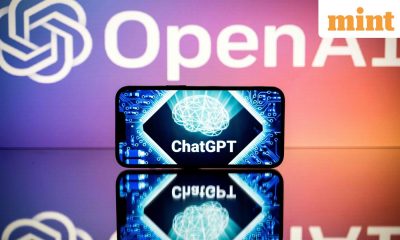Metaverse
Ex-Google CEO Eric Schmidt feels US is lagging in the AI race, while China has THESE advantages | 5 points – Crypto News
Former Google CEO Eric Schmidt feels that despite huge valuations and funding the United States is lagging behind China in the artificial intelligence (AI) tech race. Speaking at the All-In Summit on September 25, Schmidt shared his views on how China has out raced the US in AI, where American companies need to shift their focus, and what possible measures the west can take to catch up.
Schmidt noted that while US tech companies working in the AI field are largely pursuing artificial general intelligence or AGI, the Chinese are more focused on AI applications. He also noted that the overwhelming use of Open Source and Open Code projects from the Chinese means that their alternatives are more easily accessible and likely to be more widely adopted.
Schmidt also acknowledged that while Chinese companies in the AI space may not have $100 billion valuations, they have not been as hard hit by US imposing bans on chips and semiconductors, and have their own technologies matching American capabilities.
Eric Schmidt: US not clear leader against China in AI race — 5 Points
On US and China in the AI race
Responding to a question on how the US can compete with China on AI, Schmidt noted, “I had thought that China and the US were competing at the peer level in AI; and that the good work done to restrict chips, were slowing them down. (But), they’re really doing something more different than I thought.”
He noted that China is “not pursuing crazy AGI strategies”, as they don not have “the depth of capital markets” and cannot “raise $100 million dollars on a wing and a prayer”.
“The result is, they’re very focused on taking AI and applying it to everything. And the concern I have, is that while we’re pursuing AGI, we better also be competing with the Chinese in day-to-day stuff,” he said.
Chinese making strides in practical applications
Schmidt added that the Chinese AI companies are focused on “day-to-day” stuff and combined with their “incredible” work ethics, this strategy can win.
“They’re very focused on taking AI and applying it to everything, (such as) consumer apps, robots and so on. I saw all the Shanghai robotics companies and these guys are attempting to do in robots what they’ve successfully done with electric vehicles,” he said.
Adding, “Their work ethics are incredible. They’re well funded. It’s not the crazy valuations that we have in America, but they can win across that.”
Open Source makes Chinese AI more accessible to larger audiences
The tech leader noted that the Chinese also have in lead in wide scale adoption due to the use of open source and open weights models, calling it a “major geopolitical issue”.
“Open Source means open code. Open weights means to open training data. (And) China is competing with open weights and open training data and the US is largely and majority focused on closed weights and closed data. That means that the majority of the world, think of it, as the Belt and Road initiative are going to use Chinese models and not American models,” he warned.
On US tech companies beginning work in open source
Schmidt also acknowledged that Chinese companies have “major achievements” when it comes to the technical aspects. He noted that despite moves towards more open source, DeepSeek shook the AI industry.
“The DeepSeek people did such a good job, right? If you look at the reasoning model in DeepSeek and in particular their ability to do reinforcement, learning forward and back, this is a major achievement and it appears that they’re doing it with less numeric precision than the American models,” Schmidt pointed out.
He noted that, while the American models are typically using 16-bit Precision for their training, the Chinese are pushing eight and four bit precision.
What steps can American companies take?
When asked if there were steps that American companies need to undertake in order to compete with China, Schmidt noted that the initiative has already begun, stating, “A number of the large companies have said that they want to be leaders in open source. Sam Altman indicated that the smallest version of the O3 model would be released — I believe, (it will be) open weights. He told me that this model is much smaller, much easier to train, and will or can fit on your phone.”
“So one path is to say that we’ll have these super computers doing AGI, which will always be incredibly expensive and so forth. But we also have to watch to make sure that the proliferation of these models for handheld devices is under American control. Whether it’s OpenAI or Meta, or (Google’s) Gemini or what have you,” he ended.
-

 Cryptocurrency6 days ago
Cryptocurrency6 days agoIlluminating progress: Is a $140K income ‘poor’? – Crypto News
-
Technology5 days ago
Crypto Lawyer Bill Morgan Praises Ripple’s Multi-Chain Strategy as RLUSD Hits $1.1B – Crypto News
-

 others6 days ago
others6 days agoGold holds strong at $4,200 as Fed-cut anticipation builds – Crypto News
-

 Blockchain4 days ago
Blockchain4 days agoAnalyst Reveals What You Should Look Out For – Crypto News
-
Cryptocurrency1 week ago
Crypto Platform Polymarket Relaunches in U.S. Following CFTC Approval – Crypto News
-

 Cryptocurrency1 week ago
Cryptocurrency1 week agoUK recognises crypto as property in major digital asset shift – Crypto News
-
others7 days ago
Bitcoin Price Forecast as BlackRock Sends $125M in BTC to Coinbase — Is a Crash Inevitable? – Crypto News
-

 Technology6 days ago
Technology6 days agoSamsung Galaxy S25 Ultra 5G for under ₹80,000 on Flipkart? Here’s how the deal works – Crypto News
-

 Blockchain3 days ago
Blockchain3 days agoStripe and Paradigm Open Tempo Blockchain Project to Public – Crypto News
-
others1 week ago
$12T Charles Schwab to Launch Bitcoin and Ethereum Trading in Early 2026, CEO Confirms – Crypto News
-

 Cryptocurrency1 week ago
Cryptocurrency1 week ago‘Get it done on time’ – Lawmakers push regulators on GENIUS Act rollout – Crypto News
-
Business1 week ago
Crypto Platform Polymarket Relaunches in U.S. Following CFTC Approval – Crypto News
-

 Technology7 days ago
Technology7 days agoWorking on a screen all day? These 8 LED monitors in Dec 2025 are kinder on your eyes – Crypto News
-
others6 days ago
Morgan Stanley Turns Bullish, Says Fed Will Cut Rates by 25bps This Month – Crypto News
-

 Cryptocurrency6 days ago
Cryptocurrency6 days agoFlorida Appeals Court Revives $80M Bitcoin Theft – Crypto News
-

 Cryptocurrency6 days ago
Cryptocurrency6 days agoCrypto Holiday Gift Guide 2025 – Crypto News
-
others4 days ago
Breaking: Labor Department Cancels October PPI Inflation Report Ahead of FOMC Meeting – Crypto News
-

 Cryptocurrency4 days ago
Cryptocurrency4 days agoArgentina moves to reshape crypto rules as banks prepare for Bitcoin services – Crypto News
-
others1 week ago
XRP News: Ripple Expands Payments Service With RedotPay Integration – Crypto News
-
Business1 week ago
Sui Price Surges 10% As Vanguard Group Adds SUI to Bitwise 10 Crypto Index – Crypto News
-

 Cryptocurrency1 week ago
Cryptocurrency1 week agoRipple CTO Shares Hilarious Email from Jed McCaleb Impersonator – Crypto News
-
Business1 week ago
Senator Tim Scott Floats December 17 and 18 For Crypto Market Bill Markup – Crypto News
-

 Cryptocurrency1 week ago
Cryptocurrency1 week agoBTC staking platform Babylon teams up with Aave for Bitcoin-backed DeFi insurance – Crypto News
-

 Blockchain1 week ago
Blockchain1 week agoSolana (SOL) Cools Off After Rally While Market Eyes a Resistance Break – Crypto News
-

 others6 days ago
others6 days agoThe rally to 7120 continues – Crypto News
-

 Blockchain6 days ago
Blockchain6 days agoBitcoin Buries The Tulip Myth After 17 Years: Balchunas – Crypto News
-

 others5 days ago
others5 days agoNasdaq futures hold key structure as price compresses toward major resistance zones – Crypto News
-

 others5 days ago
others5 days agoNasdaq futures hold key structure as price compresses toward major resistance zones – Crypto News
-
Business1 week ago
Trump Sets Early 2026 Timeline for New Fed Chair Pick – Crypto News
-

 Cryptocurrency1 week ago
Cryptocurrency1 week agoVanguard reverses course, opens door to Bitcoin, Ethereum, XRP, and Solana ETFs – Crypto News
-

 Blockchain1 week ago
Blockchain1 week agoLedger Finds Chip Flaw Allowing Complete Phone Takeover – Crypto News
-
Business1 week ago
Kalshi, Robinhood and Crypto com Face Cease & Desist Order in Connecticut – Crypto News
-
Business1 week ago
What’s Next for Dogecoin Price After Whales Scoop 480M DOGE? – Crypto News
-

 Technology1 week ago
Technology1 week agoCloudflare Resolved Services Issues Caused by Software Update – Crypto News
-
others1 week ago
XRP Price Prediction As Spot ETF Inflows Near $1 Billion: What’s Next? – Crypto News
-
others7 days ago
Colombia Consumer Price Index (YoY) below forecasts (5.45%) in November: Actual (5.3%) – Crypto News
-
Technology7 days ago
Solana Price Outlook: Reversal at Key Support Could Lead to $150 Target – Crypto News
-

 Technology6 days ago
Technology6 days agoFrom security camera to gaming hub: 6 Easy tricks to make your old smartphone genuinely useful again – Crypto News
-

 Cryptocurrency5 days ago
Cryptocurrency5 days agoWhy Ethereum strengthens despite whale selling – Inside Asia premium twist – Crypto News
-

 Technology5 days ago
Technology5 days agoStarlink India pricing revealed: How much does monthly plan cost and what are its benefits? – Crypto News
-
Cryptocurrency1 week ago
Hedera Price Surges 10% After Canary Capital HBAR ETF Goes Live on Vanguard – Crypto News
-

 Blockchain1 week ago
Blockchain1 week agoLeveraged ETFs Tied To Strategy Suffer Major Losses – Crypto News
-

 Metaverse1 week ago
Metaverse1 week agoIndian enterprises all-set to take an AI leap as partners guide adoption – Crypto News
-
Business1 week ago
December Fed Rate Cut Prospects Strengthen After ADP Shows Deepening Labor Market Weakness – Crypto News
-

 Blockchain1 week ago
Blockchain1 week agoTaiwan to Pass Stablecoin Regulations in Late 2026: Report – Crypto News
-

 Cryptocurrency1 week ago
Cryptocurrency1 week agoEric Trump’s American Bitcoin Steadies After ‘First Major Unlock’ of Shares – Crypto News
-

 Blockchain1 week ago
Blockchain1 week agoAnalysts Turn Bullish on SUI as Token Extends Gains Amid Renewed Institutional Interest – Crypto News
-

 Technology1 week ago
Technology1 week agoTinder says 2026 will be the year of ‘no mixed signals’ as daters embrace clarity – Crypto News
-

 Cryptocurrency1 week ago
Cryptocurrency1 week agoCayman Islands sees rising Web3 foundation activity – Crypto News
-

 Technology1 week ago
Technology1 week agoApple Watch’s latest update drops a lifesaving feature for Indian users: here’s how it works – Crypto News










